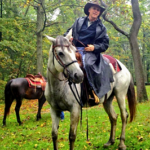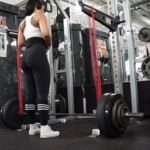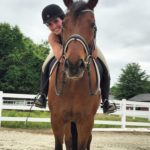
Any horse’s performance is directly related to how far he moves, how fast he responds, and how little pressure it takes from his rider giving a specific cue to get him to respond. In this article, we’ll focus on the rein cue. You’ll work on getting your horse lighter and more responsive to the bridle. You’ll also improve your horse’s performance by using a specific formula:
• What’s real?
• How far?
• How little?
• How fast?
This formula can be used over and over again in any training session to improve any specific movement from your horse.
Getting the Message Across
One of the finest compliments you can pay a horseman is to say he has “good hands.” Horses that are tense and out of balance under one rider seem to relax into buttery softness when someone with good hands climbs on board. At the same time, they become lighter and more responsive to the bridle.
Everyone wants good hands. The problem is that no one tells you exactly what good hands are or how to use the hands you’ve got so they get better. Let’s change that.
Good hands don’t depend on how your hands are shaped and they definitely have nothing to do with manicures or soft, pretty skin. They aren’t actually magic, although it certainly can look like it. It isn’t a matter of natural talent, either. The notion that, “You’re either born with ’em or forget it!” is nonsense. Good hands can be learned (see the sidebar), and horses seem to give an almost audible “Thank you!” when that happens.
Your hands communicate with the horse through a lead rope and halter when you’re on the ground or through the reins and bit when you’re in the saddle. They’re the best way of explaining to your horse what you want him to do, a direct connection from your thoughts to the horse’s brain. Your hands carry messages faster, more completely, and more subtly than a spoken conversation, a telephone line, a text message, or email.
The old-fashioned comparison be-tween the reins as a sort of telegraph line-and the newer one of the reins as a high-speed Internet connection-are both pretty accurate. But because there is no machine doing any translating between your hands and the horse’s mouth, this communication is nearly instantaneous and much more complete. Done well, it’s also a whole lot more private.
What Message Are You Sending?
Any type of communication can be positive or negative.
The telephone can be a wonderful thing, but there are many people who use it in a way that makes you dread to pick it up. Maybe the other person is trying to sell you something you really have no interest in buying. Or maybe they talk too loudly and you have to hold the receiver away from your head because it hurts your ear to hold it closer. Maybe they just go on and on and on and on… but it’s Auntie Alice and you can’t actually hang up on her because you’ll never hear the end of it from your mother if you do. Maybe it’s someone on the other end who is always so negative that it ruins your day to have to listen.
Sometimes it’s our own fault. We try to say something nice to someone, but our tongue gets wrapped in knots. Our words come out all garbled and we say the exact opposite of we intended. Understandably, the other person gets hurt or angry.
Or maybe we don’t know how to put what we mean into words, so there’s this long, uncomfortable silence while the other person waits for something-anything-to be said.
All too often, we do all of these things to our horses with our hands. Maybe we don’t give our horse any actual direction at all, but just expect him to know what we want. Or, even though we may not mean to, maybe we jerk the reins suddenly or just use way more pressure than is actually needed because we haven’t learned yet how little pressure is really necessary. Or perhaps we just nag, nag, nag, saying “Don’t, don’t, don’t.”
It’s also really easy to begin to use our reins, bit, lead rope, and halter as tools of punishment rather than communication. After all, that darned horse just (yank) won’t (yank) turn (big yank)!
We can’t use our reins for both punishment and communication because-while we want the horse to listen closely to the cue we’re about to give-he actually may begin to flinch in fear of what’s going to happen next that might hurt him. If that happens, it’s going to be hard for him to answer the phone in a relaxed, happy manner and he’ll be much less eager to hear what you have to say.

How Your Hands Should Feel and Move
Any time you’re working with your horse-whether you’re on the ground or riding-your hands should be soft, but solid. They should be slow, but giving a clear signal and ready to release.
Your hands explain what you want your horse (or a specific spot on your horse) to do. They should never, ever be reacting to what the horse has already done. They should never make the horse nervous, apprehensive, or scared, so they never punish. Your hands should be completely free of any emotion. They should never communicate anger, frustration, or any attitude, such as “Come on! You know this!” All this is easy to say, but it takes work and self-control to put into regular practice.
When you pick up on the reins, your hands should feel very, very soft to the mouth on the other end. It should be like holding your child’s hand. If you’re walking down a busy street and your child begins to pull away, your hand would slowly close and become solid, but not punishing. The second your child moves back in your direction, your hand would soften again. You would not abandon the contact completely. Your hand would be a safe, reassuring way of guiding him. This is exactly the feel, the attitude, and the tone you need to take with your horse’s rein.
His “street” would be the direction we don’t want his nose, ear, shoulder, hip, tail, concho, saddle horn, or whatever to move toward. In this situation, your hand is firm on the rein, but not tight. Again, think of holding your child’s hand. If you hold too tightly when he’s walking beside you, then he’s going to try to pull away.
Try this with a friend or your spouse. Don’t say anything-just walk over and take hold of his or her hand. Very slowly begin holding it just a little too tightly. He or she will slowly begin to pull away to get away from the uncomfortable pressure. Your horse will do the same with his nose, mouth, or any spot you work with.
Another good exercise is to tie a rope around a solid post. Pull slowly on the rope, putting more and more pressure on the post. That post will show you exactly the way your hands should feel to the horse. If you jerk hard, the post is solid. If you put a pound’s worth of pressure on the post, you will feel exactly a pound’s worth of pressure from the post.
The post doesn’t scare you by jerking back or pulling harder than you do. It doesn’t get frustrated at you because you’re pulling. It just sits there being a post. Pretty soon you stop pulling. If you release your pull, so does the post. If you release it fast, the post “releases” equally fast.
Your hands need to mimic the post for your horse. If he pulls on the reins, you don’t pull back and get rough. You just imitate the post and keep an even pressure. He may try a bit more pulling. He may try a lot more pulling. But your hands still act like the post. They don’t give up, but they don’t punish. They’re just there until he relaxes, at which time you immediately release and put slack in the rein.

Using Your New Formula
The softness in your hands comes into play when the spot on which you’re focused on your horse begins moving in the direction you do want it to go. We said at the beginning that any horse’s performance is directly related to how far, how fast, and how little pressure it takes for the rider to get a response from giving a specific cue. In this case, you’re going to use the rein cue to determine what’s real, how far, how little, and how fast.
Start by finding where your horse’s mind, skill, and abilities are today. How far can that spot move in response to your cue? (What’s real?) Next you have to know that there is always room for improvement. That improvement starts with distance. (How far?) If you can only get your horse’s body to move 3 inches to the right at one time with one touch of your rein, it’s going to take a lot of steps to get completely across the arena on a diagonal. If you can get him to reach out 4 feet in one step on one touch of that rein, then it’s going to take a lot fewer steps and fewer touches on the reins to cross that space. It will also feel fantastic!
Your horse’s steps are going to be directly related to a spot on the saddle. This can be a concho, the horn, a D-ring, or whatever makes it easy for you to keep track of one small spot moving in one direction. After all, if your right concho is moving at a steady diagonal to the right, so is the horse underneath it.
Let’s say that your spot is that right concho and you do want it to move on that steady diagonal like we practiced in the last issue. When you pick up your rein and squeeze with your legs as the “move your feet” cue, you can get the concho to move over 5 inches. You also discover that it takes 5 pounds of pressure on the rein (How little?) to get that spot to move 5 miles per hour (How fast?).
But is that the best that spot can do? Maybe you’ve been on your horse when he spooked at something. That concho moves a whole lot more than 5 inches in a good spook. It can move more like 10 feet in a single leap before his feet touch the ground, so chances are pretty good that the spot can do a whole lot better than 5 inches with some work. It just doesn’t know how yet.
Where No Spot Has Gone Before
So today we’re going to take that spot where no spot has gone before. Your first step is going to be to increase the distance, but you have to be realistic and know that little changes are the best way to get a big improvement.
At first, you’ll only ask for 6 inches of diagonal movement and you’ll probably have to do a little more work to get that. You might have to use more than 5 pounds of pressure on the reins. But if you have a clear picture of what you want your horse to do and are quietly persistent, within a few minutes you will be getting that concho to move six inches over the ground. It may only be a small increase, but it’s important that you have improved your horse’s performance.
He’s doing it, but he’s heavy in your hands, so next you will focus on lightness by teaching your horse to respond with less rein pressure. It’s normal to think that if your horse isn’t responding as quickly or as lightly as you think he should, you should be quicker with the cue. However, the opposite is what works.
Whenever you want your horse to become lighter to an aid, we have to slow the aid down. This will give him time to respond to less pressure. During this next step, focus on your hands picking up that rein extra, extra slowly. This gives the horse much more time to respond to less pressure. But it’s critical that you do not go backwards and accept less distance from the concho.
If the concho only moves 3 inches or the original 5 inches the first two or three times, very slowly increase that rein pressure until you are back to 6 inches. After 5 or 10 repetitions of this, you will begin to see the concho responding before you get the slack out of the rein. Now the concho is moving 6 inches on half an ounce of pressure.
You’ve improved two areas of your horse’s performance: distance and light- ness. Now you’re ready for the last area: speed.
The spot started out at 5 miles per hour, and that’s slower than you want it to be. When focusing on speed it would, again, seem normal to try to get things moving faster by pulling harder on the rein. But you now know that asking for more speed is your legs’ responsibility. Direction has nothing to do with speed, so hauling harder or faster on the reins will not improve how quickly your horse covers ground.
It may help to ignore for the moment that you’re asking for a diagonal movement. Picture that you’re riding your horse down a straight, narrow trail or road. You squeeze evenly with both legs to either walk faster or trot faster. That exact cue is what you’re going to use now. Your rein cue is what will give him the direction. Again, it may take a few repetitions, but you’ll get there.
Great Expectations
So now you have improved all three areas of your horse’s performance: distance covered, lightness, and speed or reaction time in response to the aid. Now you start all over again, asking yourself, “Is 6 inches as far as that concho can go on one touch of the rein?” The answer, of course, is always no. Now the process starts all over again. First you work on distance. Perhaps this time you can get the concho to move 8 inches over on half an ounce of pressure with a more immediate response. After a little more work, maybe you get up to 12 inches. Keep asking, little by little, and you’ll be amazed by how light and limber your horse becomes.
Remember that if you’re asking your horse to do a movement that requires him to stretch muscles he hasn’t used that way before, those little increases will be important so he can gradually build his flexibility and strength.
Improvement doesn’t come automatically. It comes after you ask, “Is this the best my horse can do?” You have to learn to raise your expectations of what your horse is capable of. This has to be followed by a plan, which needs to be carried out with clear signals and small steps. Then your horse raises his performance level.
All you ever need to figure out is a fair way to explain the improvement you would like to get from him, and never just punish him when he’s not doing what you want. If he doesn’t do what you want, he doesn’t understand and you must teach him more. If he truly understands what you want, he’ll try. He’s always satisfied when you’re satisfied and he’s happy when you’re happy.
And you will have developed good hands.







